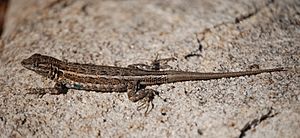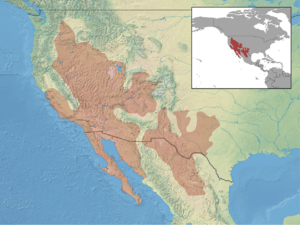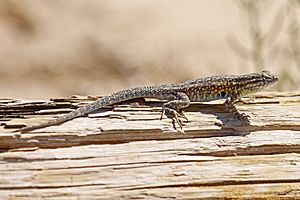Common side-blotched lizard facts for kids
Quick facts for kids Common side-blotched lizard |
|
|---|---|
 |
|
| Scientific classification | |
| Genus: |
Uta
|
| Species: |
stansburiana
|
| Subspecies | |
|
|
 |
|
| Synonyms | |
|
|
The common side-blotched lizard (Uta stansburiana) is a small lizard found in dry areas. These lizards live in the western United States and northern Mexico. They are famous for their unique way of finding mates. Male lizards have three different throat colors. Each color shows a different strategy for attracting females. These strategies work like a game of rock-paper-scissors. One type of male might beat another, but then lose to a third type.
Contents
About the Name
The lizard's scientific name, stansburiana, honors Captain Howard Stansbury. He was an engineer who explored the Great Salt Lake in Utah. Captain Stansbury collected the first lizards of this kind between 1849 and 1851.
What Side-Blotched Lizards Look Like
The common side-blotched lizard is a small iguanid lizard. Males can grow up to 60 millimeters (about 2.4 inches) long from their snout to their tail base. Females are usually a bit smaller.
Their colors can be different depending on their sex and where they live. Some males have blue spots on their backs and tails. Their sides might be yellow or orange. Other males might not have any patterns. Females can have stripes or be plain. Both males and females have a clear dark spot on their side, right behind their front legs.
Color is very important for these lizards. It is linked to how males and females behave when they are looking for a mate.
How Side-Blotched Lizards Live
Mating Strategies
The Rock-Paper-Scissors Game
Male side-blotched lizards have different throat colors: orange, blue, or yellow. Each color shows a different way of competing for mates. This variety helps keep all three types of males in the population. The type of male that is least common one year often has the most babies the next year. This is because each type has an advantage over one other type, but a disadvantage against the third.
- Orange-throated males are the biggest and most aggressive. They control large areas of land, about the size of a small house yard. They gather many females to mate with. These males are good at taking mates from blue-throated males. However, orange-throated males do not live as long as the other two types.
- Blue-throated males are medium-sized. They guard smaller territories, usually with only one female. Since they only have one mate to protect, they are better at stopping yellow-throated "sneakers." But, larger orange-throated males can steal their mates.
- Yellow-throated males are "sneakers." They look a lot like female lizards. They pretend to be females when they meet orange- or blue-throated males. Yellow-throated males do not have their own territories. Instead, they roam widely, overlapping with other lizards' areas. They use their disguise to secretly mate with females that are not being watched. This is easier to do in the large groups of females kept by orange-throated males. Sometimes, a yellow-throated male can even change into a blue-throated male. This often happens if a nearby dominant male dies.
Genes and Throat Color
The color of a lizard's throat is passed down through its genes. It's like a single gene with three different versions, or alleles.
- The 'o' allele (for orange) is the strongest.
- The 'b' allele (for blue) is weaker than the 'y' allele (for yellow).
This means:
- Orange-throated males have at least one 'o' allele.
- Yellow-throated males have 'yy' or 'yb' genes.
- Blue-throated males only have 'bb' genes.
Hormones like testosterone also play a big part. Orange-throated males have much higher testosterone levels. If other males get more testosterone, they become more aggressive and control larger areas, just like orange-throated males. When a yellow-throated male changes to blue, its testosterone levels also go up.
Having Babies
Female side-blotched lizards lay about 5 eggs at a time, but can lay up to 9. Females with yellow throats tend to lay fewer, larger eggs. Females with orange throats lay more, smaller eggs. The larger eggs usually have a better chance of surviving.
Fighting and Courting
Male side-blotched lizards are aggressive when protecting their territory. When another lizard enters their space, they become alert. They do "pushups" (bobbing their heads up and down), arch their backs, and stretch their legs. Then they approach the intruder. If it's another male, they might rush, butt, or nip at it until it runs away.
If it's a female, the male will start to court her. This involves circling, biting her side gently, licking, smelling, and smaller head bobs. Males will try to court any smaller lizard that seems passive, even other species.
Tail length is also important for social status. Like many lizards, they can drop their tails to escape predators. But a shorter tail means lower social status for both males and females. Males drop their tails less often than females. This is because social status is more important for male lizards to find mates.
What They Eat
Side-blotched lizards mostly eat arthropods, like insects and spiders. What they eat can change with the seasons and depends on what bugs are available. Males and females might eat different things. This could be because their behaviors are different, like guarding territories or attracting mates. Or, it might help reduce competition for food, with smaller females eating smaller prey.
How New Species Form
The "rock-paper-scissors" mating strategy has been around for millions of years. But sometimes, a group of lizards might lose one of the male throat colors. When this happens, they can become a new species. This is because they become separated from other groups that still have all three types of males. The "sneaker" male is the one most often lost.
When a male type is lost, the other types change. For example, female lizards might start preferring different mates. This can lead to bigger differences in size between males and females. Also, predators might start hunting the remaining types of lizards differently.
Lizard Health
Like most animals, side-blotched lizards can get parasites. These include tiny worms and mites. Parasites can affect how much energy the lizards have and how well they can have babies. This is because their bodies use energy to fight off the infection.
Images for kids




